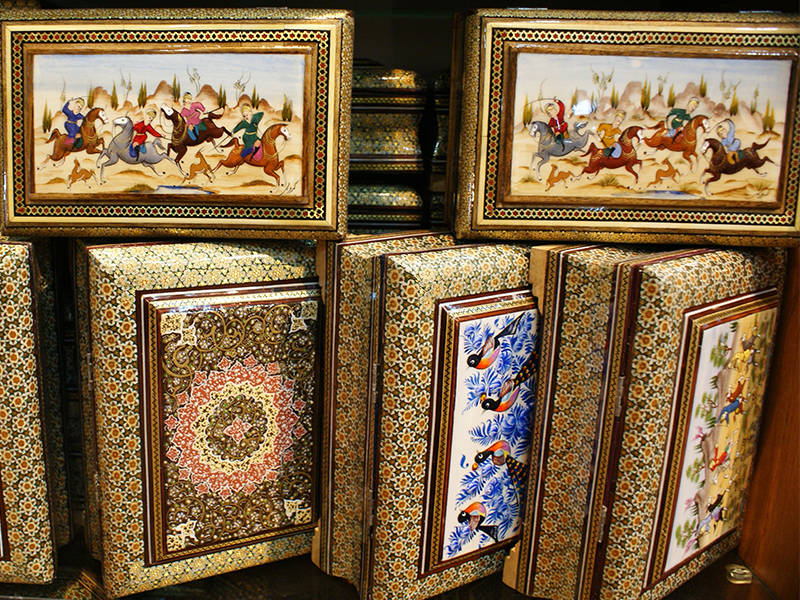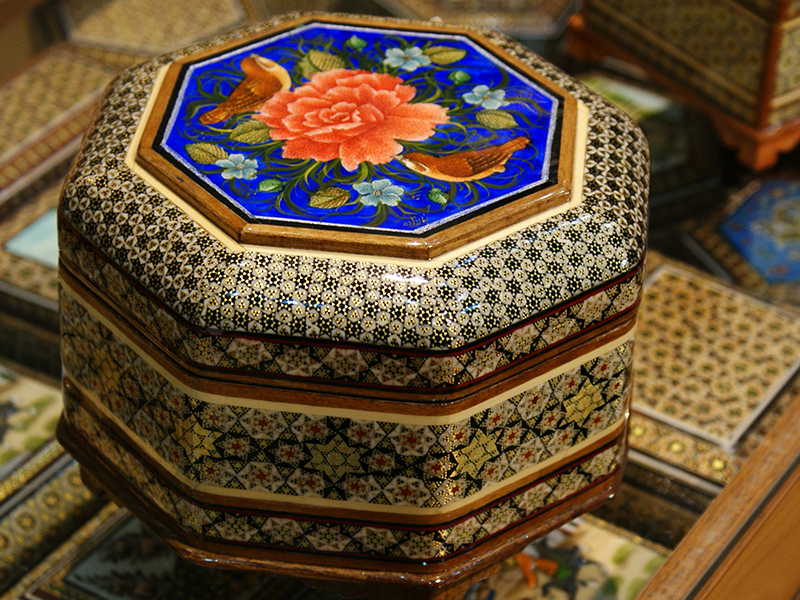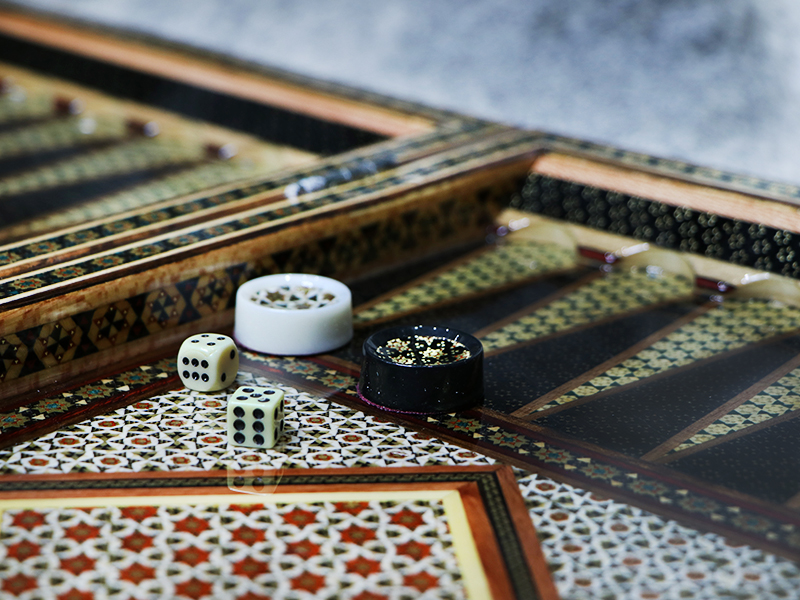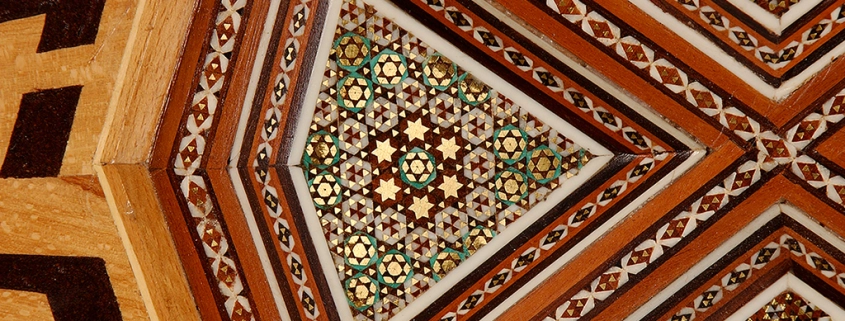What is Marquetry? (History, Design, Tools)
Marquetry is a centuries-old art form that embodies the subtle blending of artistic expression on a metal or wood surface. Skilled artists produce beautiful designs and complex patterns that adorn furniture, musical instruments, and decorative objects by carefully arranging layers on wood.
The French verb “marqueter,” which means “to variegate,” is where the word “marquetry” originates from, referring to the art form’s capacity to enliven surfaces with a vibrant tapestry of colors, grains, and textures.
Marquetry is also one of the oldest art forms in Iran that has been passed on from generation to generation. Let’s learn more.
What Is Marquetry?
To create complex patterns and motifs, thin wood veneers are arranged in a decorative woodworking process called marquetry. It sprang from ancient cultures and became well-known in the Renaissance.
Veneers are expertly chosen and cut by artisans who take texture, color, and grain into account. After that, the components are adhered to a foundation material to produce shading and depth.
Marquetry has been used to adorn cabinets, furniture, and artwork. It calls for dexterity, accuracy, and a thorough grasp of wood.
It is still done today by talented craftspeople all around the world, and it is valued for its artistry and beauty. Marquetry works are prized for their fine features exhibited in museums.
Beautiful pieces of art are created through a meticulous process that mixes artistic expression with the natural beauty of wood.
Khatam Kari
Khatamkari, also known as Persian marquetry, is the oldest traditional art form in Iran, where wooden or metallic objects are decorated with pieces of wood, bone, and metal in various shapes and designs.

This intricate craft involves the use of materials such as gold, silver, brass, and twisted wire. The designs are created by assembling thin sticks of wood, brass, and camel bones into triangular beams, which are then glued together to form geometrical motifs.
Khatamkari has a long history in Iran, with examples found in historical mosques, palaces, and buildings. Today, this art is still practiced in cities like Isfahan, Shiraz, and Tehran.
Persian Marquetry
Iran is the birthplace of Persian marquetry, a unique style of marquetry. It displays the exquisite craftsmanship and rich artistic legacy of Persian culture.
Persian marquetry is a tribute to the creative tradition of the nation, distinguished by its elaborate geometric patterns, floral themes, and scenarios derived from Persian literature and mythology.
Expert craftsmen place wood veneers in captivating patterns by carefully choosing and assembling them. The pieces gain depth and grandeur via the use of priceless materials like mother-of-pearl, brass, camel bone, and wood.
Persian marquetry is well known for its fine craftsmanship, meticulous attention to detail, and blending of art and culture. It is still loved and practiced all around the world, keeping ancient methods alive and encouraging modern artists to explore new avenues for this enthralling medium.
Persian Marquetry History
Iran has a long history of Persian marquetry, which reached its peak under the Safavid dynasty (1501–1736) and is still going strong. Influenced by Islamic themes, cultural customs, and Persian art.
This artistic medium has been incorporated into furniture, décor, and architectural aspects. The Qajar era is notable for the development of the Khatam Kari technique, which involves exact inlay work using materials including wood, brass, and bone.

Persian marquetry is a blend of workmanship, artistic expression, and cultural legacy. Iranian artists now preserve the ancient methods while adding modern interpretations. Persian Marquetry is today one of the significances of Iran’s culture.
Marquetry Design
Marquetry Designs vary from one country to another. You can see different Marquetry Designs and Marquetry Patterns in the cultural essence of any nation. Persian marquetry patterns include elaborate figurative, calligraphic, Persian floral, geometric, paisley, and symmetrical designs.
These motifs, which draw inspiration from Persian art and architecture, reflect Iran’s rich artistic history. Roses, tulips, and lotuses are shown in delicate floral patterns, while other Persian elements provide interlacing geometric compositions.
Interlocking elements, polygons, and stars are common features in geometric designs. Paisley’s designs add sophistication and cultural significance.
Calligraphy is expertly incorporated with beautiful Persian writings. Figurative patterns provide storytelling aspects by representing people, animals, and legendary creatures. Fretwork patterns use complex woven patterns that resemble lace or ribbons.
Harmony and balance are reflected in symmetrical patterns. Persian marquetry designs combine painstaking craftsmanship, symbolic cultural meaning, and creative vision to create visually arresting and culturally significant artwork that showcases Iran’s artistic heritage.
Marquetry Tools
Marquetry Tools are necessary for executing the technique. Key instruments include coping saws for complex curved cuts, fret saws or scroll saws for cutting veneers, chisels for shaping edges, and craft knives or scalpels for delicate detail work. Sandpaper aids in achieving a polished finish, and veneers are pressed and smoothed with veneer hammers and burnishing tools.

For a secure attachment, materials such as veneer glue and clamps are needed. Veneer saws for accurate cutting, veneer softeners for pliability, and veneer tape for temporary holding are further equipment.
These instruments help artists to produce complex marquetry designs with skill and attention to detail. Accurate and exquisite marquetry work requires the correct tools, whether for shaping, cutting, assembling, or finishing.
Marquetry Wood
Diverse Marquetry Woods is used for this beautiful art medium. The range of wood species that are frequently used in the marquetry art form is referred to as marquetry wood. The wood choice should be carefully considered to achieve desired aesthetics and create visually pleasing designs.
Because of its lovely grain patterns and warm brown tone, walnut is a popular option. Maple can be used as a backdrop or to create contrast because of its light tone and delicate texture.
Rosewood’s unique texture and rich reddish-brown color lend an opulent touch. Ebony creates dramatic contrast or emphasis because of its smooth texture and deep black color.
Satinwood is used frequently for highlights and delicate details because of its bright appearance. Mahogany provides warm characteristics with its straight grain and deep reddish-brown tone.
Both boxwood and ash add texture; boxwood is good for finer work, and ash adds visual appeal.
Artists can combine these different wood species to create marquetry creations that are aesthetically appealing and fascinating.
Marquetry Table
A marquetry table is a useful piece of furniture with a beautiful design on the top. Marquetry tables are available in a variety of forms and can be used as side tables, coffee tables, or dining tables. They become the center of attention in any room because of their elegance and creative flare.

A Persian marquetry table blends elements of Persian design with the age-old craft of marquetry. It includes elaborate designs and themes, including floral patterns, geometric shapes, and depictions of Persian architecture, that are influenced by Persian art and culture.
Persian marquetry tables give style and cultural value to any area while serving as utilitarian and beautiful pieces.
Marquetry Handcrafts
The marquetry requires care, accuracy, and a constant focus on detail. Handcrafted marquetry pieces proudly display the natural beauty of wood veneers, the skillful inlay techniques used, and the ability to create visually striking compositions.
They are treasured as priceless pieces of art that perfectly capture the ability and creative genius of talented craftspeople. Whether incorporated into useful pieces or left on their own, marquetry handcrafts elegantly provide refinement and stunning beauty to rooms. Some of the most unique Marquety are found as Isfahan’s handicrafts.
Final Words
In a nutshell, Persian marquetry is a remarkable representation of the Iranian people’s extraordinary artistry and cultural expression, and it bears witness to the country’s rich artistic legacy.
Persian marquetry has a centuries-long history and has developed into a unique art style with geometric designs, floral themes, and sceneries based on Persian literature and mythology.
The captivating pieces that radiate beauty and sophistication are the product of the careful attention to detail and the deft application of wood veneers. Persian marquetry is a visual depiction of the artistic heritage of the nation.
Are you planning to travel to Iran and looking for an Iran resort? Consider Matinabad Eco-resort.





Leave a Reply
Want to join the discussion?Feel free to contribute!